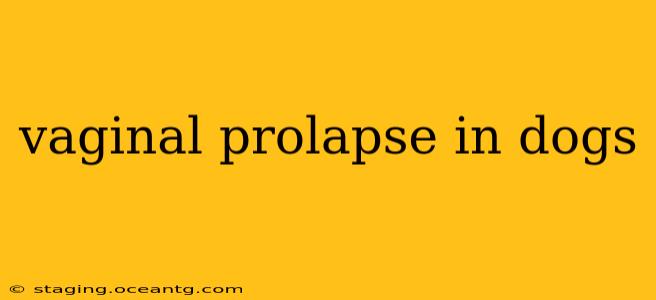Vaginal prolapse in dogs is a distressing condition where the vaginal wall inverts and protrudes outside the vulva. This can range from a mild swelling to a significant, bloody mass. While it's more common in certain breeds and during specific life stages, understanding the causes, symptoms, and treatment options is crucial for any dog owner. This comprehensive guide will explore everything you need to know about vaginal prolapse in canine companions.
What is Vaginal Prolapse in Dogs?
Vaginal prolapse refers to the inversion and protrusion of the vaginal mucosa (the lining of the vagina) through the vulva. Imagine the vagina turning inside out. This can be a partial prolapse, where only a small portion is visible, or a complete prolapse, involving a larger, more noticeable mass. The severity can vary greatly, and the prolapsed tissue can appear swollen, red, and even bleed.
What Causes Vaginal Prolapse in Dogs?
Several factors contribute to the development of vaginal prolapse in dogs. Understanding these underlying causes is key to effective prevention and treatment.
Straining:
- Difficult Defecation or Urination: Constipation, urinary tract infections, or other conditions causing straining during elimination can put pressure on the vaginal wall, leading to prolapse.
- Parturition (Childbirth): The intense straining during labor and delivery is a significant risk factor, especially in large litters or difficult births.
Hormonal Factors:
- Estrogen Deficiency: A decline in estrogen levels, often seen in older dogs or those who have been spayed, can weaken the vaginal tissues, making them more susceptible to prolapse.
- Pregnancy: The hormonal changes during pregnancy can also contribute to the weakening of vaginal tissues.
Breed Predisposition:
Certain breeds appear to be more prone to vaginal prolapse than others, although the exact reasons aren't fully understood. These often include brachycephalic (short-nosed) breeds.
Other Contributing Factors:
- Obesity: Excess weight can increase strain on the pelvic floor muscles.
- Chronic Coughing: Persistent coughing can increase abdominal pressure, contributing to prolapse.
What are the Symptoms of Vaginal Prolapse in Dogs?
The most obvious symptom is the visible protrusion of tissue from the vulva. This can range from a small, pink swelling to a large, dark red mass that may be bleeding. Other potential symptoms include:
- Difficulty Urinating or Defecating: The prolapse itself can obstruct the urinary and fecal pathways.
- Licking or Pawing at the Vulva: Your dog may show discomfort and try to groom the affected area.
- Lethargy or Depression: The pain and discomfort can lead to changes in behavior.
- Loss of Appetite: This is often a secondary symptom related to pain and discomfort.
How is Vaginal Prolapse in Dogs Diagnosed?
Diagnosis is usually straightforward based on a physical examination. Your veterinarian will visually inspect the vulva and vaginal area to confirm the presence and severity of the prolapse. Further tests may be conducted to rule out other underlying conditions, such as urinary tract infections or other pelvic problems.
What are the Treatment Options for Vaginal Prolapse in Dogs?
Treatment options vary depending on the severity of the prolapse and your dog's overall health.
Manual Reduction:
In some cases, especially with mild prolapses, the veterinarian may be able to gently reposition the prolapsed tissue back into the vagina. This is often done under anesthesia.
Surgical Repair:
For more severe or recurring prolapses, surgery is usually necessary. The surgical procedure involves repositioning the vaginal tissue and often involves suturing the area to prevent further prolapse. In some cases, the veterinarian might remove the affected tissue.
Supportive Care:
Post-surgical care may include pain management, antibiotics to prevent infection, and monitoring for complications. Your veterinarian will provide specific instructions based on your dog's individual needs.
How Can I Prevent Vaginal Prolapse in My Dog?
While not all cases of vaginal prolapse are preventable, certain steps can reduce the risk:
- Maintain a Healthy Weight: Obesity significantly increases the risk.
- Address Constipation and Urinary Tract Issues Promptly: Consult your veterinarian if your dog is having difficulty defecating or urinating.
- Manage Chronic Coughing: If your dog has a persistent cough, seek veterinary attention to determine the underlying cause and implement appropriate treatment.
What is the Prognosis for Dogs with Vaginal Prolapse?
The prognosis for vaginal prolapse is generally good with appropriate treatment. The success rate of surgical repair is high, and most dogs recover well with proper post-operative care. However, recurrence is possible, particularly in dogs with underlying conditions or those who continue to strain.
What is the recovery time for a dog after vaginal prolapse surgery?
Recovery time varies depending on the extent of the surgery and your dog's individual healing process. It typically ranges from a few weeks to several months. Your veterinarian will provide specific instructions on post-operative care, including pain management, activity restriction, and wound monitoring. Regular follow-up appointments are essential to assess healing progress and address any potential complications.
Can vaginal prolapse happen in unspayed dogs?
Yes, vaginal prolapse can occur in unspayed dogs, although it is more common in spayed females due to hormonal changes and subsequent weakening of vaginal tissues. Straining during pregnancy or whelping (giving birth) can also lead to prolapse in intact females.
Is vaginal prolapse painful for dogs?
Yes, vaginal prolapse can be painful for dogs. The exposed tissue is vulnerable to irritation, infection, and injury. Dogs may exhibit signs of discomfort such as licking, pawing at the area, lethargy, and changes in appetite. Pain management is an important aspect of treatment, both surgically and medically.
This information is for educational purposes only and should not be considered veterinary advice. Always consult with your veterinarian for diagnosis and treatment of any medical condition in your dog. Early intervention is key to achieving the best possible outcome for your canine companion.
